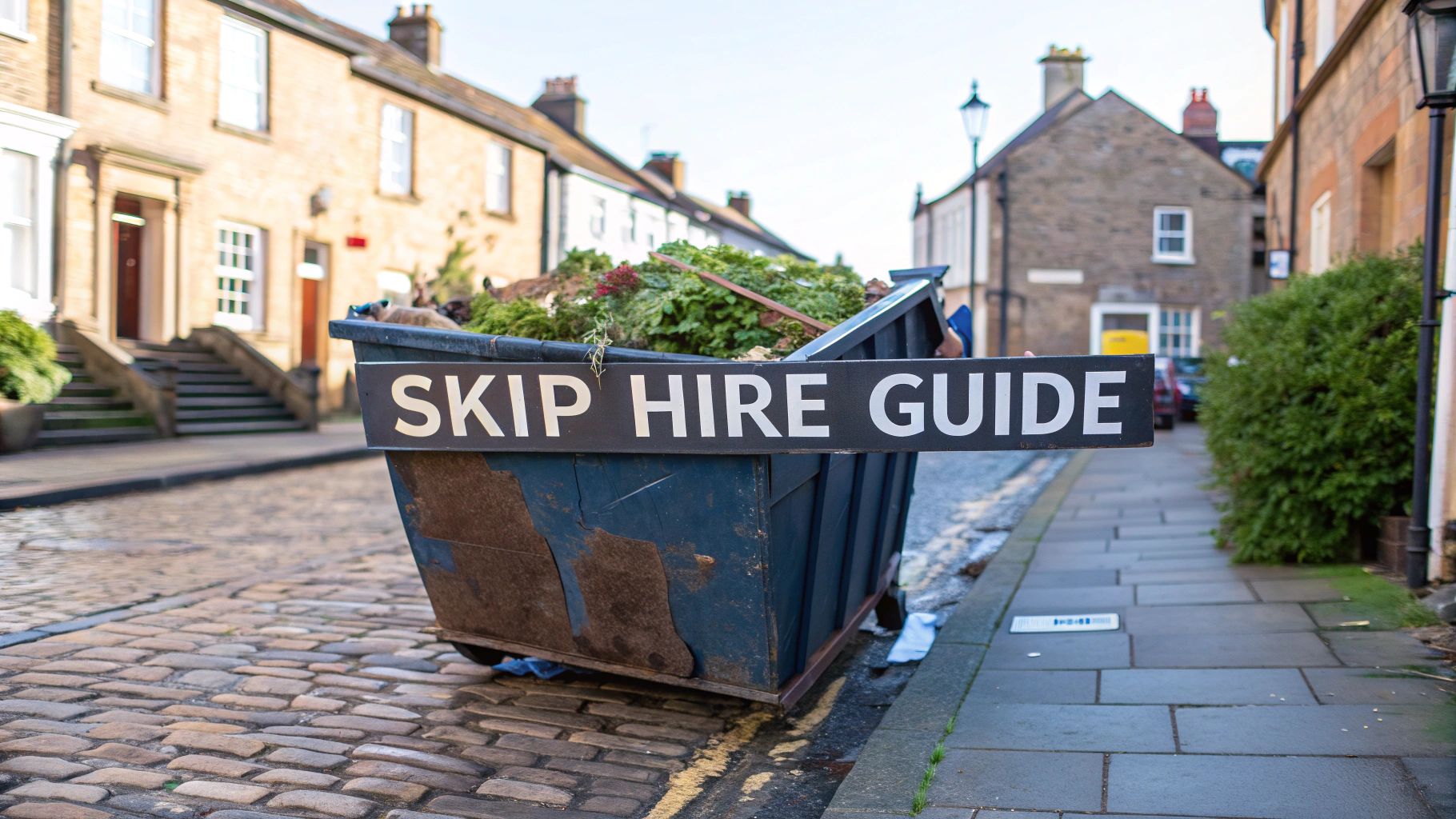Skip Hire for Garden Waste A Practical Guide
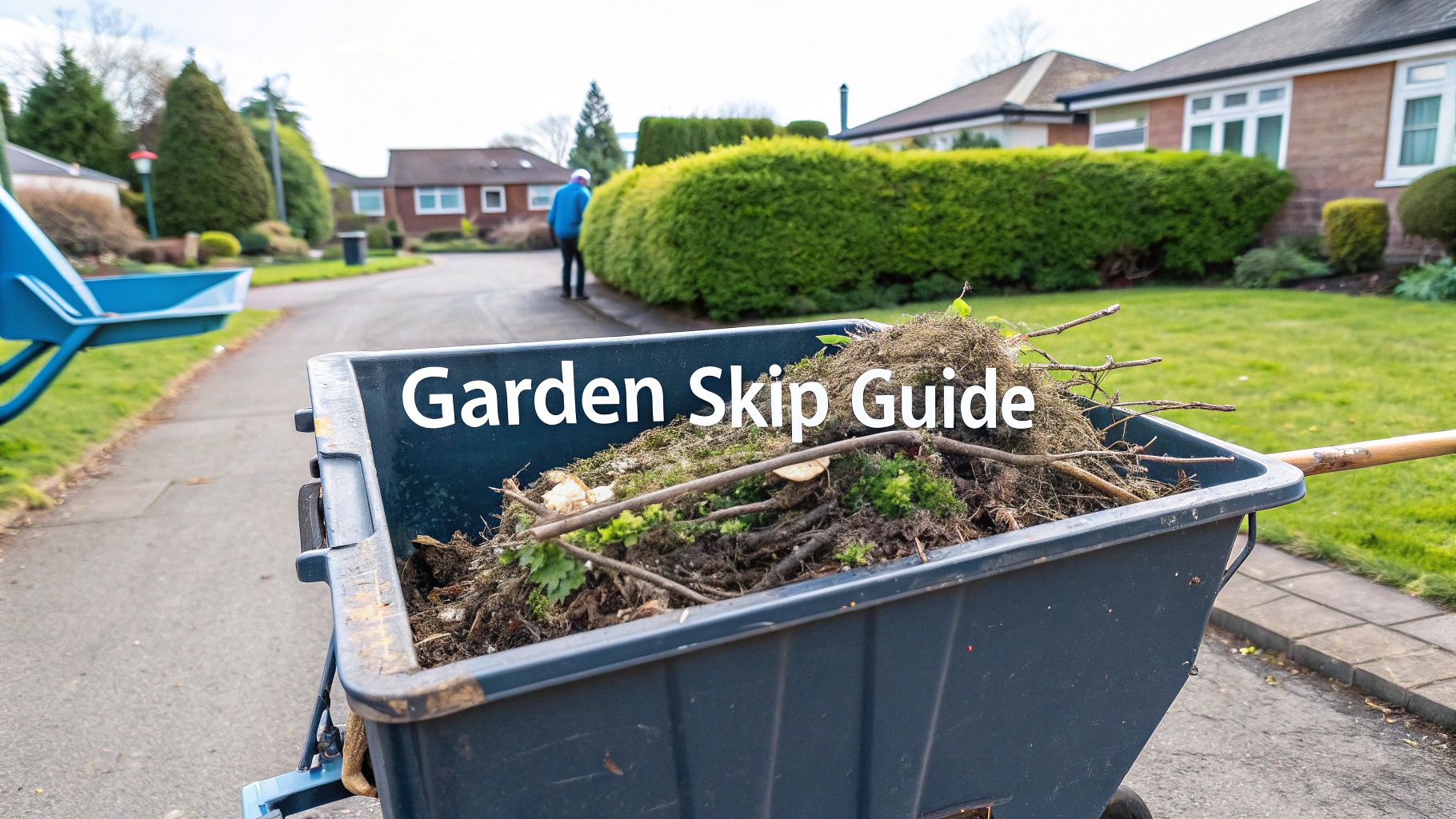
Skip Hire for Garden Waste A Practical Guide
That mountain of clippings, soil, and old turf after a big garden project can be a bit of a shock.While your regular council bin is perfectly fine for weekly trims, it just can’t handle the sheer volume from a major clear-out. This is exactly where skip hire for garden waste becomes your best friend – it’s the most practical and efficient way to get the job done.
When Is a Skip Your Best Bet for Garden Waste?
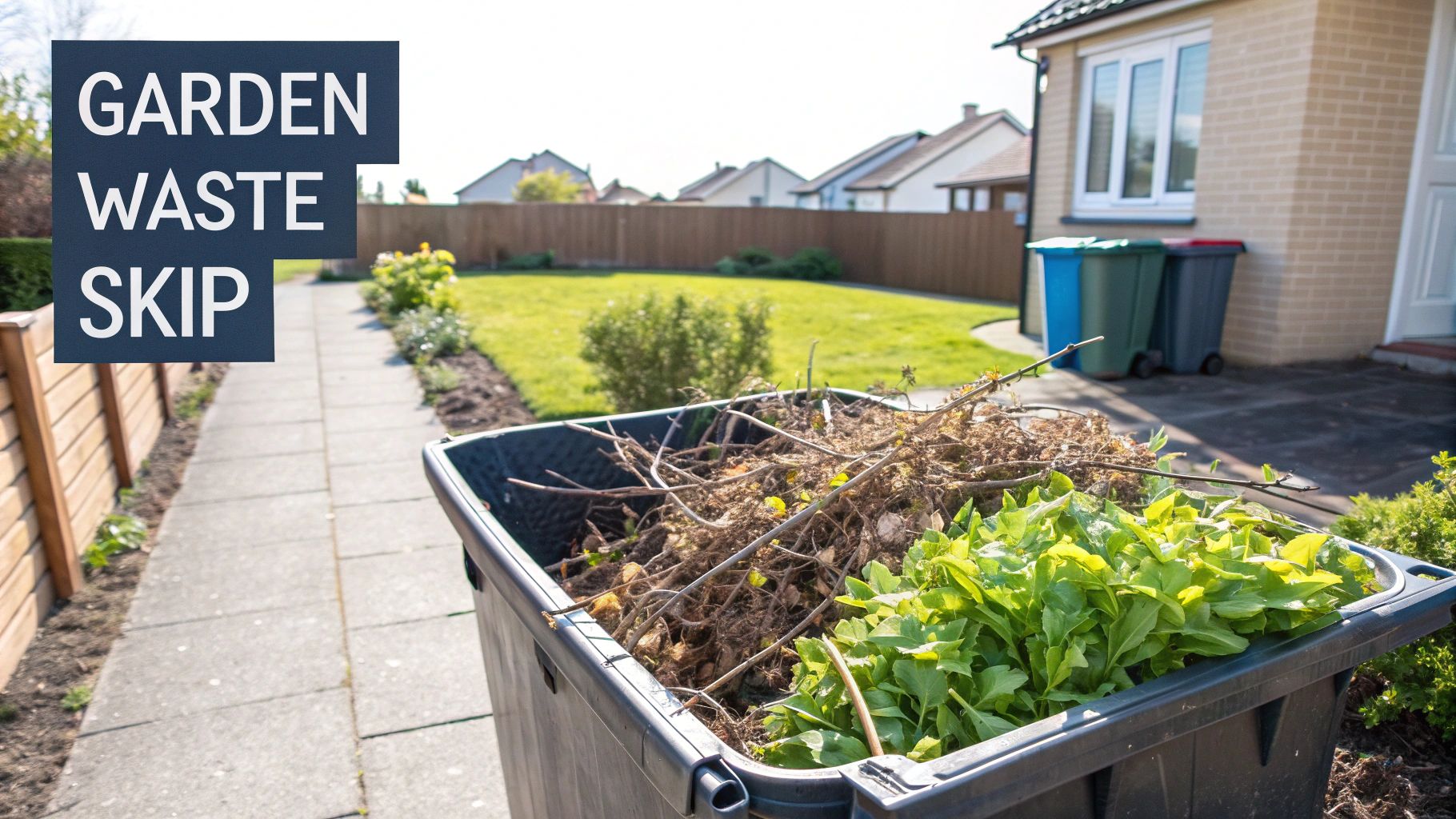
Let’s get real for a moment. Some garden projects are just on another level, generating far more green waste than your car boot can handle or your local council can collect. A skip isn’t just a big metal box; it’s a project management tool that saves you time, fuel, and a whole lot of faff.
Large-Scale Garden Clearances
Have you taken on a garden that’s been left to its own devices for a few years? I’ve seen it many times. Reclaiming a wild, overgrown space means dealing with a surprising amount of waste – thick branches, stubborn weeds with deep roots, and exhausted old soil. A skip gives you a central place to chuck it all, keeping your property tidy and saving you from countless trips to the tip.
Major Landscaping and Redesign Projects
A proper garden transformation is rarely just about planting a few new flowers. You might be digging out foundations for a new patio, ripping up an old lawn to lay fresh turf, or excavating for a pond. These jobs create a lot of heavy, awkward waste like soil, rubble, and old turf.
For really ambitious projects like a large-scale swimming pool construction, a huge volume of earth has to go somewhere. In these cases, hiring a skip isn’t just a good idea, it’s an essential part of the plan.
Seasonal Overhauls and Tree Surgery
That big spring clean or autumn cut-back always produces more clippings and cuttings than you expect. The same goes for professional tree surgery. Once the experts are done, you can be left with hefty logs and branches that have no chance of fitting in your green bin. A skip makes clearing this seasonal surge of organic material simple and stress-free.
A skip hire streamlines the entire process, allowing you to focus on the garden work itself, not the logistics of waste removal. It’s the difference between a project that feels organised and one that feels chaotic.
It’s also worth remembering the pressure our local waste services are under. Take Brighton, for example. In the year ending March 2024, the city collected a massive 111,049 tonnes of waste, with garden refuse making up a big chunk of that. This just shows how vital services like skip hire are for managing these larger, one-off clear-outs that council collections aren’t designed for.
Choosing the Right Skip Size for Your Garden Project
Picking the right skip for your garden clear-out is probably the most important decision you’ll make. It directly impacts your budget and how smoothly the whole project runs. Guessing can be a costly mistake. If you order one that’s too small, you’ll find yourself paying for a second delivery just to clear what’s left. Go too big, and you’ve essentially paid to transport fresh air.
Let’s move beyond the jargon and get practical, so you can book your skip hire for garden waste with total confidence.
Decoding Skip Sizes in Real Terms
Forget abstract measurements for a moment. The easiest way to get a real feel for skip capacity is to think in terms of things you use all the time, like wheelbarrows and standard council bin bags.
A simple weekend tidy-up—a bit of pruning, some weeding, and clearing away last season’s leaves—will almost certainly fit into the smallest skips available. No problem at all.
But what about a more ambitious project? If you’re tackling something like digging up an old, tired lawn or clearing a small, overgrown patio area, you’ll be shocked at how much heavy waste you generate. This is where you need to start thinking about a bigger size to avoid any headaches.
Here’s a quick rundown of the most common sizes I see people using for garden jobs:
- 2-Yard ‘Mini’ Skip: This is your perfect companion for those small, weekend clear-outs. It holds around 20 standard bin bags, or about 8 to 10 wheelbarrow loads. It’s absolutely ideal for an annual border clear-out or trimming back a few unruly shrubs.
- 4-Yard ‘Midi’ Skip: A really popular choice for medium-sized garden projects, and for good reason. It can comfortably take about 40 bin bags worth of cuttings, turf, and soil. This is the right call for bigger jobs like ripping out an old lawn or clearing a significantly overgrown patch of land.
- 8-Yard ‘Builder’s’ Skip: This one is reserved for the biggest garden overhauls and serious landscaping jobs. Holding up to 80 bin bags, it’s the go-to for major redesigns that produce a mix of soil, turf, chunky branches, and old patio slabs.
To give you a better sense of scale, the image below shows how these capacities compare at a glance.
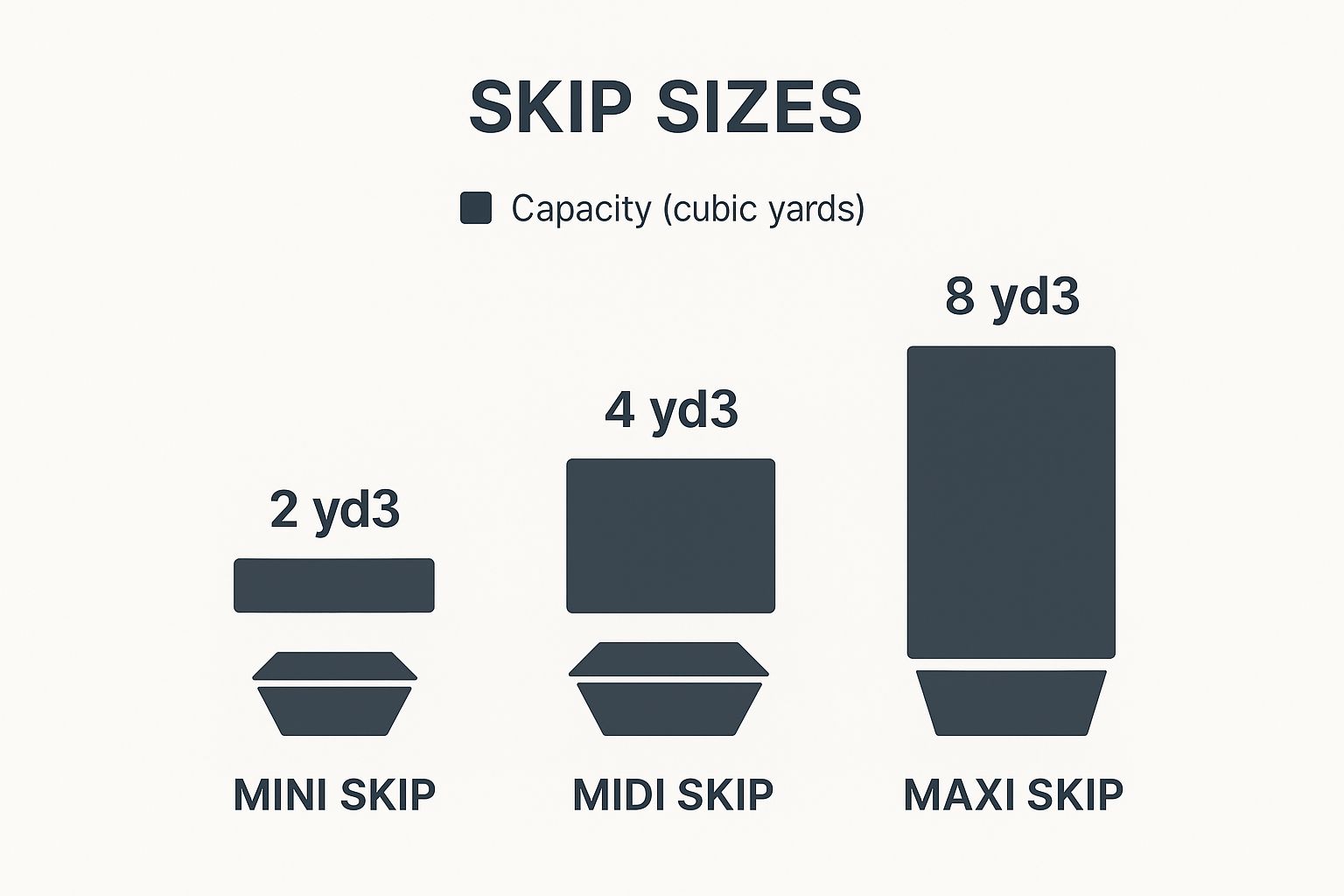
As you can tell, the jump in volume between each size is pretty significant. It really drives home why taking a moment to estimate your waste is so crucial.
Matching the Skip to Your Project and Budget
The price of skip hire for garden waste is, of course, directly linked to its size. To give you a rough idea of what to expect, I’ve put together this quick guide based on typical UK costs. Bear in mind that prices can vary a bit depending on your exact location.
Garden Skip Size and Cost Guide
| Skip Size (Cubic Yards) | Typical Project | Capacity (Approx. Bin Bags) | Estimated Cost Range (£) |
|---|---|---|---|
| 2 Yard (Mini) | Small garden tidy-up, hedge trimming, weeding | 20 | £120 – £200 |
| 4 Yard (Midi) | Clearing an overgrown patch, removing a small lawn | 40 | £180 – £300 |
| 8 Yard (Builder’s) | Major landscaping, large tree/shrub removal, soil/turf | 80 | £250 – £400 |
Getting the right size is about more than just having enough space; it’s also about what you’re throwing away. If you’re getting rid of a lot of heavy waste like soil and turf, be aware that most skip companies will restrict this type of material to skips of 8 yards or smaller. The reason is simple: a larger skip filled with soil could easily become too heavy for the collection lorry to lift legally and safely.
My Pro Tip: When you’re genuinely on the fence, it’s almost always more cost-effective to go one size up. The price difference between a 2-yard and a 4-yard skip is far less than the cost and hassle of hiring a second 2-yard skip down the line.
If you’re still a bit unsure after reading this, we’ve got a more detailed guide that breaks down what size skip you might need for all sorts of different projects.
Dealing with Skip Permits and Placement
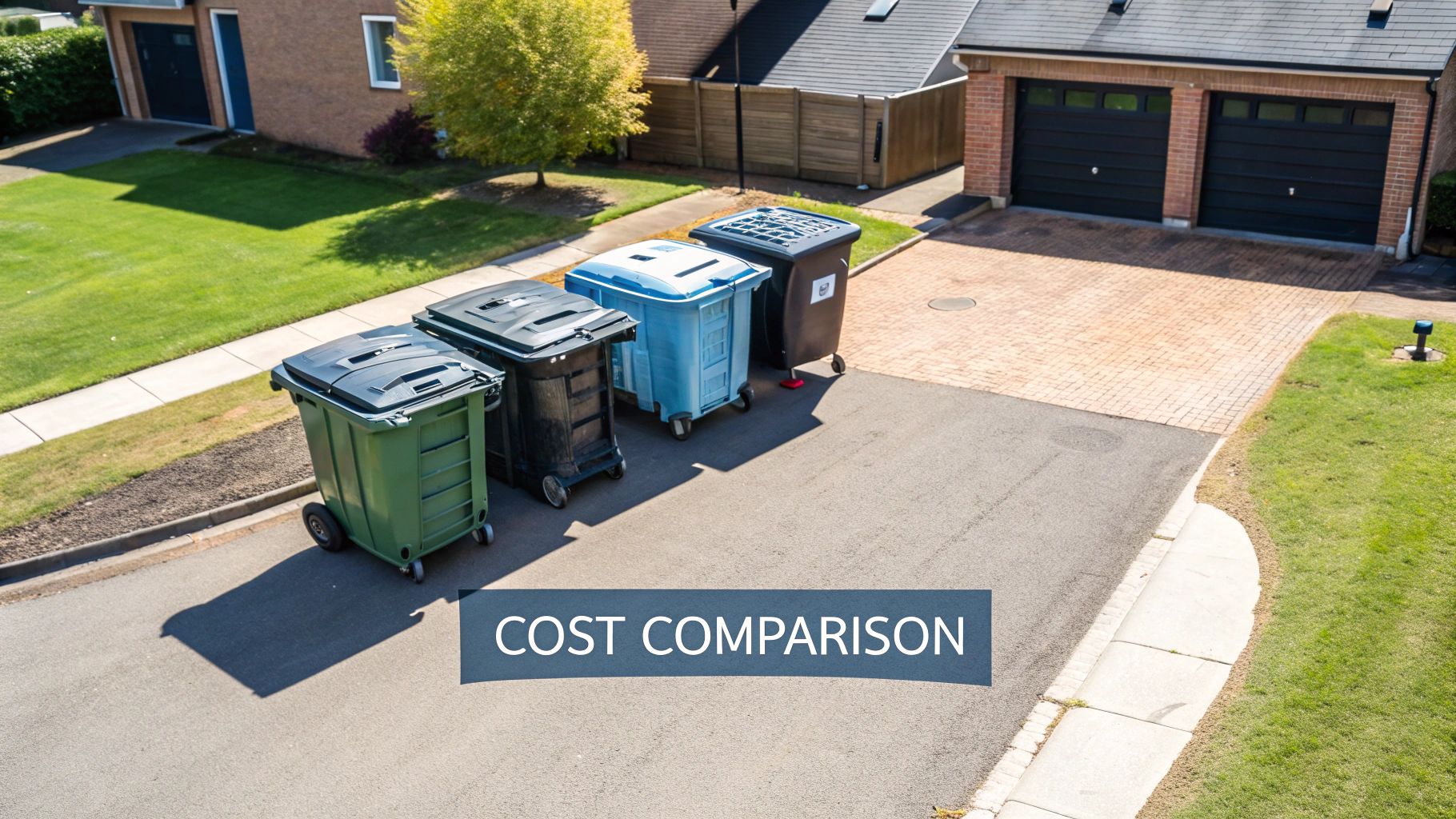
So, you’ve picked the right size skip for your garden clear-out. The next big question is a simple one: where are you going to put it? The answer isn’t just about convenience; it determines whether you need to get the council involved, which can add extra time and money to your skip hire for garden waste.
If you’ve got the space on your own land – a driveway or a patch of garden you don’t mind marking up – that’s always your best bet. It’s private property, so no permit is needed. Plus, it makes loading up all that green waste so much easier.
Of course, not everyone has that luxury, especially if you live in a terraced house or have limited off-street parking. When the only realistic spot is on a public road, pavement, or grass verge, you are legally required to have a skip permit from your local council.
Understanding the Skip Permit Process
Don’t panic, this doesn’t mean you’ll be stuck navigating council websites and paperwork. The skip hire company is responsible for sorting this out. As registered waste carriers, they handle the application process for you.
Just make sure you tell them the skip needs to go on public land when you book.
A few things to keep in mind:
- Lead Time: Give your skip provider plenty of warning. It can take anywhere from 3 to 7 working days for a council to approve a permit, so booking a skip for tomorrow isn’t going to work if you need it on the road.
- Cost: The permit fee is set by the local council and will be added to your bill. Prices vary quite a bit across the UK, but you can typically expect to pay between £30 and £100.
- Duration: Permits don’t last forever. They’re usually issued for one or two weeks. If your garden project runs over and you need the skip for longer, you’ll probably have to pay for a permit renewal.
Trying to dodge the permit fee is a classic false economy. If you place a skip on a public road without one, you’re risking a hefty fine from the council. They’ll also order you to have it removed immediately, which could bring your whole project to a grinding halt.
Preparing Your Site for a Smooth Delivery
A bit of prep work before the skip arrives can save you a world of hassle on delivery day. Take five minutes to walk the route and check the spot where the skip will be dropped. Are there any low-hanging tree branches, parked cars, or tight gateways that could get in the way of the delivery lorry?
If the skip is going on your driveway, it’s a brilliant idea to protect the surface. A fully loaded skip is incredibly heavy, and its metal feet can easily scratch paving slabs or crack tarmac.
A simple trick is to lay down a few thick wooden planks or old scaffold boards where the skip will rest. This helps spread the weight and prevents any lasting damage. It’s a tiny bit of effort that could save you a costly repair bill down the line.
How to Load Your Skip for Maximum Space

Just chucking garden waste into your skip as you clear it is one of the most common mistakes you can make. It’s a surefire way to create big air pockets, waste a massive amount of valuable space, and potentially force you to order another skip.
Loading a skip properly isn’t about being overly neat; it’s a strategic game that makes sure you get every penny’s worth from your hire. Think of it like packing a suitcase for a long holiday, not just chucking things in a bin. By sorting your waste and loading it in a specific order, you’ll be amazed at how much you can fit in. A well-packed skip can be the difference between a one-skip job and a costly two-skip nightmare.
The Foundation Layer Is Everything
First things first, get your heaviest and flattest items in. This is the solid base that everything else will sit on. Get this part right, and the rest is easy.
- Soil and Turf: If you’re digging up a lawn or clearing out borders, get all that soil and turf spread across the bottom of the skip. It’s dense, it’s heavy, and it creates a perfectly flat, stable layer.
- Rubble and Slabs: Any old paving slabs, bricks, or bits of rubble should also go at the bottom. The key is to arrange them as flatly as you can to stop them creating awkward angles later on.
This solid base does more than just stabilise the skip; it stops lighter, fluffier waste from getting trapped underneath and creating empty pockets. It’s a simple first move that pays off massively when you hire a skip for garden waste.
Breaking Down the Bulky Items
With your solid base sorted, it’s time to deal with the bulky, awkward stuff. This is where you can make some serious space savings. The golden rule is simple: if it can be broken down, break it down.
Grab those large branches and tree limbs and cut them into smaller, more manageable lengths. Lay them flat on top of your soil base, packing them in as tightly as you can from one end of the skip to the other. Whatever you do, resist the urge to just hurl them in—placing them neatly stops them from creating a tangled, space-hogging mess.
Never underestimate how much space you can reclaim by breaking things down. A large branch can take up a huge volume with its awkward shape, but once cut into logs and laid flat, it takes up a fraction of the space.
The Final Fill with Loose Waste
Last but not least, it’s time for all the light, loose garden waste. This is your gap-filler. Things like grass clippings, leaves, weeds, and smaller trimmings are perfect for this final stage.
Shovel or tip this loose material right over the top of the flat branches. It will naturally filter down into all the nooks and crannies, compacting the entire load as it goes. For a pro-level finish, you can even carefully walk on top of the waste to press it down further, squeezing out every last bit of air. This final touch makes sure every single cubic yard you’ve paid for is put to good use.
What Can and Cannot Go in Your Garden Skip

Knowing exactly what you can and can’t toss into your garden skip is a massive part of getting the job done right. It’s not just about chucking rubbish out of sight; it’s about making sure your garden waste gets processed responsibly. When you hire a skip just for green waste, you’re plugging into a system designed to keep this brilliant material out of landfill.
Good skip hire companies work hard to make sure the organic matter you’re getting rid of is transformed into useful stuff, like quality compost or even biomass fuel. But for that to happen, the waste has to be pure. Tossing in the wrong items can contaminate the whole lot, potentially landing you with extra charges or, worse, a refusal to collect.
The Green List: What Is Allowed in a Garden Skip
When you book a skip hire for garden waste, the company is expecting it to be filled with purely organic and inert materials from your garden. Keeping your waste stream “clean” is the golden rule.
Here’s a quick rundown of what’s perfectly fine to include:
- Green Waste: This is the big one. It covers all the usual suspects like grass cuttings, leaves, weeds, flowers, hedge trimmings, and small twigs.
- Branches and Wood: Larger branches and untreated wood from pruned trees or shrubs are absolutely fine. Just remember those loading tips from earlier—chop them down to maximise your space!
- Soil and Turf: Earth, soil, and old turf are all acceptable. The only thing to watch is the weight; heavy loads like soil can sometimes mean you’re restricted on the size of skip you can use.
- Stones and Rubble: A small amount of stone or rubble that you’ve dug up from your garden beds is also generally accepted.
By sticking to this list, you’re doing your bit to ensure your garden waste gets a second life. The skip hire industry is a key player here. In some areas, for example, 93% of domestic waste—which includes a lot of garden refuse—is handled by skip companies that focus on diverting it to composting facilities.
Sticking to the rules isn’t just about avoiding a penalty. It’s a collective effort that helps create more sustainable waste management and keeps valuable organic material from being buried in landfill sites.
The Red List: Prohibited Items You Must Avoid
This is where things can go wrong. Putting prohibited items into your garden skip is a fast track to problems. Contamination is a huge headache for waste processors, and some items are banned for safety, environmental, or legal reasons. Get it wrong, and you could be facing extra fees.
Here are the common culprits you absolutely cannot put in a dedicated garden skip:
- Treated or Painted Wood: This means old fence panels, shed parts, or decking that has been painted, stained, or pressure-treated. These contain chemicals that will ruin the composting process.
- Plastics: Think plastic plant pots, seed trays, compost bags, and any other type of plastic sheeting or packaging.
- General Household Waste: Kitchen food scraps, old furniture, textiles, or anything else from your black bin has no place here. If you need to get rid of a mix of household and garden items, you’ll need to check what can go in a general waste skip instead.
- Hazardous Materials: This is the most serious category and it’s completely non-negotiable. Items like chemical weed killers, pesticides, paint tins, asbestos, batteries, and oils are strictly forbidden and need specialist disposal services.
Common Questions About Garden Skip Hire
Even with the best-laid plans, it’s completely normal to have a few nagging questions before you commit to hiring a skip. To help you feel confident you’re making the right choice, we’ve rounded up some of the most common queries we get from customers just like you.
How Long Can I Actually Keep the Skip?
The standard hire period is usually somewhere between 7 and 14 days, which gives most people plenty of time to tackle their garden project.
But life happens, and things are almost always flexible. If you have a productive weekend and get the job done early, a quick phone call to the hire company is all it takes to arrange an earlier collection.
On the flip side, if the Great British weather decides not to cooperate or you’ve unearthed more waste than you bargained for, you can normally extend the hire. This usually comes with an extra daily or weekly charge. It’s always best to ask about the standard hire duration and any extension costs when you book, just to avoid any surprises down the line.
Is It Okay to Put Soil in a Garden Skip?
Yes, absolutely. Soil is one of the most common things people put in a garden skip.
The main thing to remember is just how dense and heavy soil is. A skip filled with earth weighs a staggering amount. Because of this, most skip companies will ask you to use a smaller skip—usually an 8-yard skip or smaller—for heavy waste like soil, turf, and rubble.
This isn’t a sneaky way to get you to pay more; it’s a crucial safety and legal requirement. A large skip filled to the brim with heavy materials can easily be too heavy for the collection lorry to lift legally and safely.
A full 12-yard skip of soil can weigh well over 10 tonnes, far exceeding the safe lifting capacity of a standard skip lorry. Sticking to smaller skips for heavy waste ensures a safe and smooth collection for everyone involved.
Which Is Cheaper: a Skip or a Skip Bag?
This really comes down to how much waste you’re getting rid of.
For a very small clear-out—think one or two car boot loads—a skip bag can often be the cheaper and more convenient option. They’re also brilliant for fitting into tight spots where a bulky, rigid skip just won’t go.
For almost any project bigger than that, though, a traditional skip offers much better value for your money. A 4-yard “midi” skip, for instance, holds a lot more than even the biggest skip bags, bringing your cost per cubic yard of waste right down. The initial price tag doesn’t always tell the whole story; you can learn more about why the lowest price isn’t always best in our detailed article.
Do I Need to Be Home for Delivery and Collection?
In most cases, no. As long as you’ve given crystal clear instructions on where you want the skip placed and the spot is completely clear and accessible, you don’t need to hang around. If it’s going on your driveway and there are no parked cars in the way, the driver can get it sorted without you.
The same goes for collection. The only time you might need to be there is if the placement is particularly fiddly, requires getting through a locked gate, or if you’ve arranged to pay the driver in cash on arrival.
Ready to get your garden project underway with zero hassle? At The Waste Group, we offer reliable, next-day skip hire for garden waste across Dorset. With our price-match guarantee and commitment to recycling, you can be sure you’re getting the best value and service. Book your skip online today at https://www.thewastegroup.co.uk.
Article created using Outrank
